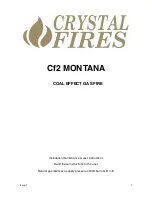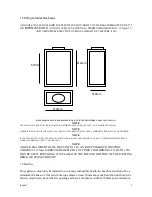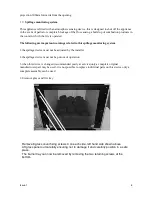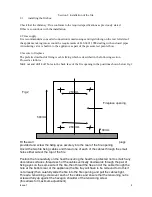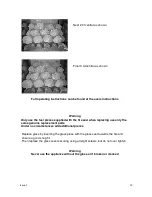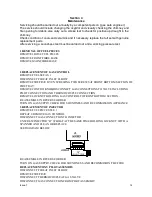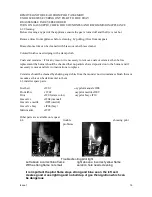
1.3 Fireplace / surround suitability
The fire must only be installed on a hearth it must not be installed directly on to a carpet or
other combustible floor materials.
(this appliance may be installed without a hearth when fitted as a hole in the wall and is
fitted so the bottom of the appliance is installed a minimum of 300mm from floor level)
This fire is suitable for fitting to a non combustible fire place surrounds and proprietary
fireplace surrounds with a temperature rating of at least 150º C (class “o”)
If this appliance is fitted directly against a wall without the use of a fire surround or
fireplace all combustible materials must be removed from behind the trim .soft wall
coverings such as blown vinyl ,wall paper etc, could be affected by the rising hot air
scorching and /or discoloration may result ,due consideration should be made to
this when installing or decorating.
1.4 Shelf position
The fire may be fitted below a combustible shelf providing there is a minimum distance of
200mm above the top of the fire and the shelf does not project more than 150mm.if the
shelf overhangs more than 150mm the distance between the fire and the shelf must be
increased by 15mm for every 25mm of additional overhang over 150mm
1.5 Flue / Chimney inspection
Before commencing installation ,a flue or chimney should be inspected to ensure that all of
the following conditions are satisfied.
1.check that the chimney / flue only serves one fireplace and is clear of any
obstruction .any dampers or register plates must be removed or securely locked in the
open position
2.brick/stone built chimneys or any chimney or flue which has been used for an appliance
burning fuel other than gas must be thoroughly swept .the base of the chimney /flue must
also be cleared of debris etc
3.any under floor air supply to the fireplace must be completely sealed off
4.ensure that the inside of the chimney / flue is in good condition along its length and
check that there is no leakage of smoke through the structure of the chimney / flue during
and after the smoke pellet test
5.using a smoke pellet check there is an updraft in the chimney / flue and that the smoke
can be seen coming from the terminal/ pot outside
There must be no leakage of smoke through the structure of the chimney during or after
the smoke pellet test and it is important to check the inside upstairs rooms adjacent to the
chimney / flue
Check the chimney pot / terminal and general condition of the brickwork and masonry.if the
chimney / flue is in poor condition or if there is no up-draught do not proceed with the
installation,if there is a history of down draught conditions with the chimney / flue,
A tested and certificated flue terminal or cowl suitable for the relevant flue type should be
considered
6.
a spillage test must always be carried out during commissioning of this appliance
Issue 1
!
5

